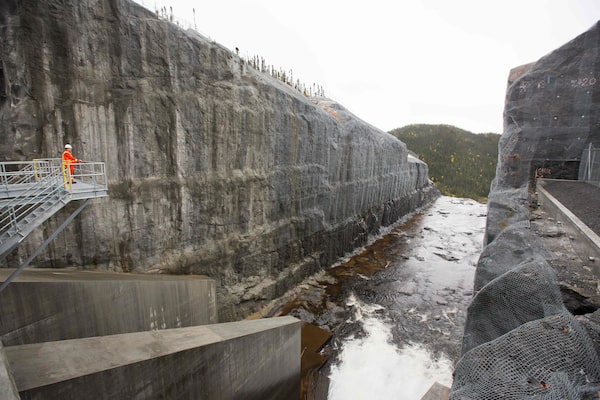
A Hydro-Quebec employee looks out over the spillway for Romaine 3 hydroelectric dam in the Côte-Nord Administrative Region of Quebec, on Oct. 4, 2018.LARS HAGBERG/AFP/Getty Images
It’s cold outside. And for Hydro-Québec, the low temperatures mean cold hard cash.
The Quebec government-owned utility has seen spot market export prices spike as the same cold wave that has hit Central Canada grips the northeastern United States. This comes after a colder-than-usual November and December helped pad Hydro-Québec’s export revenues, building on record exports during the first nine months of 2018.
By all accounts, the country’s largest power company, with revenue of $13.4-billion in 2017, appears to be admirably fulfilling its mandate, ensuring Quebec residential and industrial consumers have access to low-cost electricity, all while providing juicy proceeds for the provincial government. In 2017 alone, Hydro-Québec poured $3.2-billion into provincial coffers in the form of dividends and taxes. That accounted for more than 5 per cent of the Quebec government’s own-source revenues.
Yet, behind those impressive numbers, a new study has unearthed potentially more troubling ones.
Labour productivity at Hydro-Québec is now lower than it was in 2000. And so-called multifactor productivity, which measures the efficient use of both labour and capital, has fallen 20 per cent in the past decade.
“No net gains in labour productivity have been recorded in the last 20 years,” says the report released Monday by the Centre sur la productivité et la prospérité at HEC Montréal. “This means that Hydro-Québec generates less wealth per hour worked than it did 17 years ago.”
The 43-page report reads like a lamentation on two lost decades, as the utility invested in more expensive hydroelectric dams and government-mandated wind-power contracts that have saddled it with huge electricity surpluses. The latter forced Hydro-Québec to dump the equivalent of 10 terawatt-hours of electricity from its overflowing hydro reservoirs in 2018, depriving it of an estimated $500-million in export revenue.
The report concludes Hydro-Québec has done a less-than-optimal job of managing its assets. Were it not for its legacy, decades-old dams and access to cheap power from the Churchill Falls generating station in Labrador, it would likely operate in the red.
Hydro-Québec buys wind power from private producers at rates of between 10 cents and 12 cents a kilowatt-hour, even though it charges its own residential consumers an average of 7.13 cents a kwh. Big industrial users pay even less – or about 4.9 cents a kwh in 2018. Rates are at least twice as high in Ontario.
Those big surpluses and Hydro-Québec’s losses on existing wind energy contracts prompted Coalition Avenir Québec Premier François Legault in November to suspend a deal negotiated by the previous Liberal government under which the utility was to buy power from an Indigenous-backed wind power project on Quebec’s remote North Shore.
The contract’s suspension was no doubt a relief to Hydro-Québec chief executive Éric Martel, who had warned that the utility stood to lose as much as $2-billion on the Apuiat project over two decades. The disagreement between Mr. Martel and his Liberal political masters over Apuiat was followed by the November resignation of Liberal appointee Michael Penner as Hydro-Québec chairman. Mr. Legault appointed former Rio Tinto Alcan head Jacinthe Côté to replace Mr. Penner.
Mr. Martel, a former Bombardier executive picked to run Hydro-Québec in 2015, has made getting more out of Hydro-Québec’s existing assets a top priority, with the aim of doubling revenues to around $27-billion by 2030. That involves massively increasing exports to absorb existing surpluses and to compensate for potentially declining demand in Quebec, as more consumers install rooftop solar panels on their homes.
Several northeastern states have announced plans to dramatically increase renewable energy purchases in coming years. Hydro-Québec, which bills its power as 100-per-cent carbon free, is well positioned to capture a sizable chunk of that demand. But its partners first need to win approval for more cross-border transmission lines, while opposition to proposed new lines through New Hampshire and Maine remains stiff.
Hydro-Québec also recently signed new collective agreements that provide for more flexible employee schedules. The aim is to cut down on overtime payments, which have surged in recent years. Still, the new contracts, which grant average wage increases of 10 per cent over five years, are considered generous by private-sector standards.
To boost productivity, Mr. Martel will need to avoid the errors of the past two decades. Until then, those hefty surpluses are tantamount to pouring money down the drain.
 Konrad Yakabuski
Konrad Yakabuski